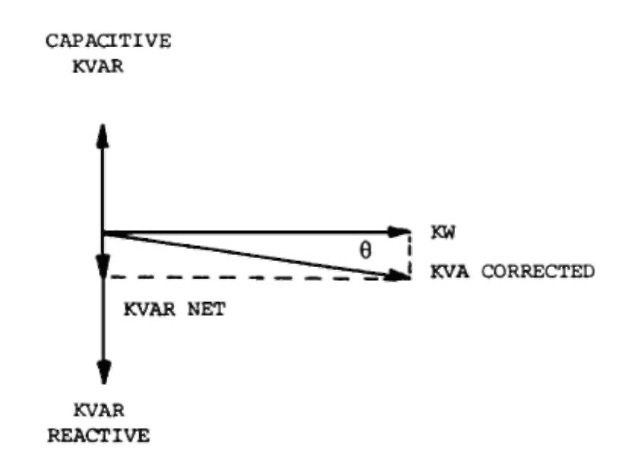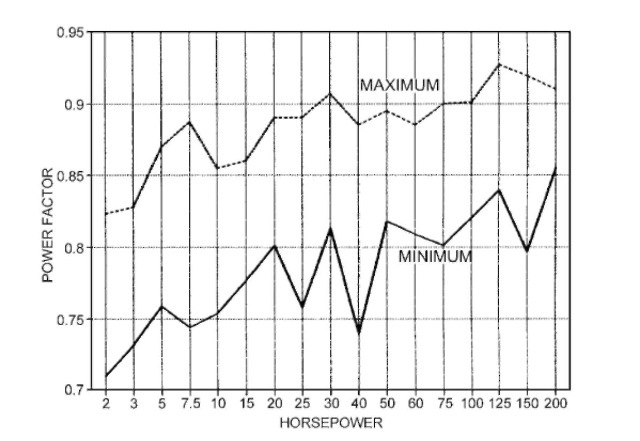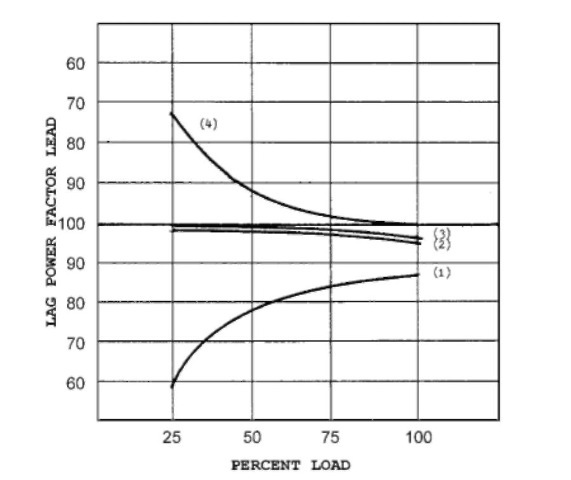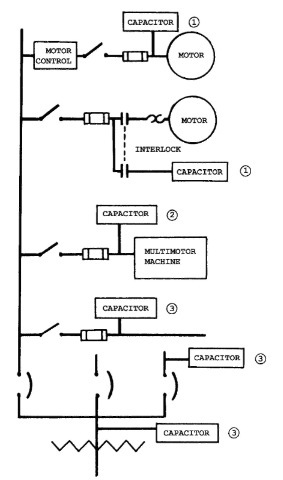4.4
FACTOR
To improve the power factor for a given load, the reactive load component (kvar) must be reduced. This component of reactive power lags the power component (kW input) by 90 electrical degrees, so that one way to reduce the effect of this component is to introduce a reactive power component that leads the power
component by 90 electrical degrees. This can be accomplished by the use of a power capacitor, as illustrated in the power diagram in Fig. 4.5, resulting in a net decrease in the angle 6 or an increase in the power factor.
Several methods are used to improve the power factor in a system installation. One method that can be employed in large systems is to use synchronous motors to drive low-speed loads that require continuous operation. A typical application for a synchronous motor is driving a low-speed air compressor, which provides process compressed air for the plant. The synchronous motor is adjusted to operate at a leading power factor and thus provide leading kilovars to offset the lagging kilovar of inductive-type loads such as induction motors.
Synchronous motors are usually designed to operate at an 80% leading power factor and to draw current that leads the line voltage rather than lags it, as is the case with induction motors and transformers. For example, consider a load of 2000 kW at a 70% lagging power factor. The utilization of a 200-hp synchronous motor operating at an 80% leading power factor will increase the overall system power factor from 70% lagging to 85% lagging.

FIGURE 4.5 Vector diagram of power input with a power factor correction.
The more popular method of improving the power factor on low-voltage distribution systems is to use power capacitors to supply the leading reactive power required. The amount and location of the corrective capacitance must be determined from a survey of the distribution system and the source of the low-power factor loads. In addition, the total initial cost and payback time of the capacitor installation must be considered.
To reduce the system losses, the power factor correction capacitors should be electrically located as close to the low-power factor loads as possible. In some cases, the capacitors can be located at a particular power feeder. In other cases, with large-horsepower motors, the capacitors can be connected as close to the motor terminals as possible. The power factor capacitors are connected across the power lines in parallel with the low-power factor load.
The number of kilovars of capacitors required depends on the power factor without correction and the desired corrected value of the power factor.
The power factor and kilovars without correction can be determined by measuring the power factor, line amperes, and line voltage at the point of correction. For a three-phase system,
![tmpFE-9_thumb[1] tmpFE-9_thumb[1]](http://lh5.ggpht.com/_X6JnoL0U4BY/S1f1eDjNDGI/AAAAAAAAHWA/uMoLttfNB68/tmpFE9_thumb1_thumb.jpg?imgmax=800)
Or the line kilowatts, line amperes, and line voltage can be measured. Then,
![tmpFE-10_thumb[1] tmpFE-10_thumb[1]](http://lh4.ggpht.com/_X6JnoL0U4BY/S1f1gIos16I/AAAAAAAAHWI/0cenaj6Iw9I/tmpFE10_thumb1_thumb.jpg?imgmax=800)
The capacitive kilovars required to raise the system to the desired power factor can be calculated as follows:
![tmpFE-11_thumb[1] tmpFE-11_thumb[1]](http://lh4.ggpht.com/_X6JnoL0U4BY/S1f1iRRPltI/AAAAAAAAHWQ/5kUHoafzUk0/tmpFE11_thumb1_thumb.jpg?imgmax=800)
where PF is the desired power factor.
For example, consider a 1000-kW load with a 60% power factor, which one wishes to correct to 90%:
![tmpFE-12_thumb[1] tmpFE-12_thumb[1]](http://lh4.ggpht.com/_X6JnoL0U4BY/S1f1kB3MWVI/AAAAAAAAHWY/06pEtWocZsc/tmpFE12_thumb1_thumb.jpg?imgmax=800)
Tables such as Table 4.1 have been developed and are available from most power capacitor manufacturers to simplify this calculation. Table 4.1 provides a multiplier to be applied to the kilowatt load to determine the capacitive kilovars required to obtain the desired corrected power factor. Consider the same 1000-kW load with a 60% power factor which one wishes to correct to 90%. From Table 4.1, for the existing power factor (60%) and the corrected power factor (90%), the power factor correction factor is 0.849. Thus, the number of kilovars of capacitance required is 1000 x 0.849 = 849 kvar.
Let us verify this calculation:
![tmpFE-13_thumb[1] tmpFE-13_thumb[1]](http://lh4.ggpht.com/_X6JnoL0U4BY/S1f1mQ7b-tI/AAAAAAAAHWg/rKDqno9VSnA/tmpFE13_thumb1_thumb.jpg?imgmax=800)
TABLE 4.1 Power Factor Correction Factors
| Existing power factor, % | Corrected | power factor | ||
| 100% | 95% | 90% | 85% | |
| 60 | 1.333 | 1.005 | 0.849 | 0.714 |
| 62 | 1.265 | 0.937 | 0.781 | 0.646 |
| CM | 1.201 | 0.872 | 0.716 | 0.581 |
| (.;<.; | 1.138 | 0.810 | 0.654 | 0.519 |
| 68 | 1.078 | 0.750 | 0.594 | 0.459 |
| 70 | 1.020 | 0.692 | 0.536 | 0.400 |
| 7:2 | 0.964 | 0.635 | 0.480 | 0.344 |
| 71 | 0.909 | 0.580 | 0.425 | 0.289 |
| 76 | 0.855 | 0.526 | 0.371 | 0.235 |
| 78 | 0.802 | 0.474 | 0.318 | 0.183 |
| 80 | 0.750 | 0.421 | 0.266 | 0.130 |
| S1 | 0.724 | 0.395 | 0.240 | 0.104 |
| 82 | 0.698 | 0.369 | 0.214 | 0.078 |
| 8:.! | 0.672 | 0.343 | 0.188 | 0.052 |
| 84 | 0.646 | 0.317 | 0.162 | 0.026 |
| 86 | 0.620 | 0.291 | 0.135 | |
| m | 0.593 | 0.265 | 0.109 | |
| 87 | 0.567 | 0.238 | 0.082 | |
| 88 | 0.540 | 0.211 | 0.055 | |
| 89 | 0.512 | 0.184 | 0.028 | |
| 90 | 0.484 | 0.156 | ||
| 91 | 0.456 | 0.127 | ||
| 92 | 0.426 | 0.097 | ||
| 93 | 0.395 | 0.067 | ||
| 94 | 0.363 | 0.034 | ||
| 96 | 0.329 |
![tmpFE-14_thumb[1] tmpFE-14_thumb[1]](http://lh4.ggpht.com/_X6JnoL0U4BY/S1f1odg72tI/AAAAAAAAHWo/eJG4bWF-hHI/tmpFE14_thumb1_thumb.jpg?imgmax=800)
Over the years, there have been several guidelines used for the selection of induction motor power factor correction capacitors. Three of these guidelines are as follows:
1. Add corrective kilovars of capacitors equal to 90% of the motor no-load kilovolt-amperes.
2. Add corrective kilovars of capacitors equal to 100% of the motor no-load kilovolt-amperes.
3. Add corrective kilovars of capacitors equal to 50% of the motor full-load kilovolt-amperes.
Table 4.2 is a comparison of these methods of selecting correction capacitors for some typical four-pole, 1800-rpm induction motors.
TABLE 4.2 Comparison of Power Factor Correction Methods
| Motor rating, hp | Initial PF | 90% NL kVA | 100% NL kVA | 50% FL kVA | |||
| kvar | Corr. PF | kvjiv | Corr. PF | kvar | Corr. PF | ||
| Standard NEMA design B, 1800-rpm | induction motors | ||||||
| 10 | 0.843 | 3.70 | 0.979 | 4.12 | 0.987 | 5.14 | 0.999 |
| 25 | 0.853 | 8.70 | 0.980 | 9.66 | 0.988 | 12.45 | 1.000 |
| 50 | 0.863 | 12.37 | 0.962 | 13.74 | 0.970 | 23.64 | 1.000 |
| 100 | 0.903 | 19.50 | 0.973 | 21.67 | 0.978 | 45.20 | 0.997L |
| 200 | 0.905 | 37.34 | 0.973 | 41.49 | 0.978 | 89.24 | 0.997L |
| Energy- | ■Efficient, 1800-rpm | induction | motors | ||||
| 10 | 0.850 | 2.98 | 0.967 | 3.31 | 0.976 | 4.92 | 0.999 |
| 25 | 0.867 | 7.24 | 0.977 | 8.05 | 0.984 | 11.71 | 1.000 |
| 50 | 0.805 | 18.18 | 0.962 | 20.20 | 0.974 | 24.86 | 0.993 |
| 100 | 0.861 | 24.16 | 0.960 | 26.84 | 0.968 | 46.85 | 1.000 |
| 200 | 0.897 | 51.75 | 0.974 | 45.81 | 0.980 | 87.44 | 0.998L |
The question is: What is a typical motor in regard to power factor? Figure 4.6 shows the variation in full-load power factor for standard four-pole, 1800-rpm induction motors. Figure 4.6 is based on published data from 10 electric motor manufacturers. The difference in the full-load power factor for a specific horsepower rating can vary by 5 to 15 points. Therefore, it is best to know the power factor information on the specific motors requiring power factor correction. The no-load methods of selecting correction capacitors are conservative and increase the corrected power factor to 95% or higher. However, the no-load information is not readily available. In contrast, the full-load power factor and efficiency are generally available either as published literature or on the motor nameplate. These data can be used to calculate the motor power factor and input kilowatt-amperes. The use of the 50% full-load kilowatt-amperes to determine the corrective kilovars generally results in a corrected

FIGURE 4.6 Power factor Nema design B, 1800-rpm induction motors.
power factor of 0.99 or better to a slightly leading power factor. This method should be used with caution if the motor is not operating at full rated load. Under partial-load conditions, the corrected power factor can be over 0.90 leading. The higher the horsepower of the motor, the more likely it is that the corrected power factor can be leading at partial loads. A partial motor load is not an unusual condition. Studies indicate that the average load on induction motors rated 125 hp and larger ranges from 50 to 85% of full-load rating. For 1800-rpm induction motors the power factor at 50% load is usually 0.07 to 0.14 points lower than the power factor at full load. If the capacitor correction is not used to supply kilovars for other uncorrected motors on the same circuit, a value lower than 50% of the full-load input kilovolt-amperes should be used for the correction kilovars.
In the application of power factor correction capacitors at the motor location, NEMA recommends the following procedure based on the published or nameplate data for the electric motor:
1. The approximately full-load power factor can be calculated from published or nameplate data as follows:
![tmpFE-16_thumb[2] tmpFE-16_thumb[2]](http://lh5.ggpht.com/_X6JnoL0U4BY/S1f1tO5J9sI/AAAAAAAAHW4/6rAApja-RF0/tmpFE16_thumb2_thumb.jpg?imgmax=800)
where
PF = per unit power factor at full load (per unit
PF = percent PF/100) hp = rated horsepower E = rated voltage I = rated current Eff = per unit nominal full-load efficiency from published data or as marked on the motor nameplate (per unit
Eff = percent Eff/100)
2. For safety reasons, it is generally better to improve the power factor for multiple loads as a part of the plant distribution system. In those cases in which local codes or other circumstances require improving the power factor of an
individual motor, the kilovar rating of the improvement capacitor can be calculated as follows:
![tmpFE-17_thumb[1] tmpFE-17_thumb[1]](http://lh3.ggpht.com/_X6JnoL0U4BY/S1f1umoh3mI/AAAAAAAAHXA/68UkSEsjFtQ/tmpFE17_thumb1_thumb.jpg?imgmax=800)
where
kvar = rating of a three-phase power factor improvement capacitor PF,- = improved per unit power factor for the motor-capacitor combination
3. In some cases, it may be desirable to determine the resultant power factor PF-, where the power factor improvement capacitor selected within the maximum safe value specified by the motor manufacturer is known. The resultant full-load power factor PF- can be calculated from the following:
![tmpFE-18_thumb[3] tmpFE-18_thumb[3]](http://lh4.ggpht.com/_X6JnoL0U4BY/S1f1w5iB03I/AAAAAAAAHXI/d7gvC9VaZD0/tmpFE18_thumb3_thumb.jpg?imgmax=800)
Warning: In no case should power factor improvement capacitors be applied in ratings exceeding the maximum safe value specified by the motor manufacturer. Excessive improvement may cause overexcitation, resulting in high transient voltages, currents, and torques, which can increase safety hazards to personnel and cause possible damage to the motor or to the driven equipment. For additional information on safety considerations in the application of power factor improvement capacitors, see NEMA Publication No. MG2, Safety Standard for Construction and Guide for Selection, Installation and Use of Electric Motors and Generators.
The level to which the power factor should be improved depends on the economic payback in terms of the electric utility power factor penalty requirements and the system energy saved because of lower losses. In addition, the characteristic of the motor load must be considered. If the motor load is a cyclical load that varies from the rated load to a light load, the value of corrective kilovar capacitance should not result in a leading power factor at light loads.
To avoid this possibility, NEMA recommends that the maximum value of the corrective kilovars added be less than the motor no-load kilovar requirement by approximately 10%. Thus,
Maximum capacitor kvar for three-phase motors
![tmpFE-19_thumb[2] tmpFE-19_thumb[2]](http://lh4.ggpht.com/_X6JnoL0U4BY/S1f1y3YFpcI/AAAAAAAAHXQ/_bmUXamOmuM/tmpFE19_thumb2_thumb.jpg?imgmax=800)
where
INL = motor no-load line current V = motor line voltage
For example, consider a 50-hp, 1800-rpm induction motor operating on a 230-V, three-phase, 60-Hz power system. Table 4.3 shows the performance of this motor at various loads without power factor correction. Table 4.4 shows the full-load performance with various values of correction capacitor kilovars, including 100% of the no-load kilovolt-amperes (13.7 kvar) and
TABLE 4.3 Induction Motor Performance Without Power Factor Correction”
| Load | Line | Eff. | PF | kW input | kVA | kvar |
| Full load | 118.7 | 0.915 | 0.862 | 40.8 | 47.3 | 24.0 |
| 3/4 load | 89.4 | 0.922 | 0.852 | 30.3 | 35.6 | 18.6 |
| 1/2 load | 64.8 | 0.920 | 0.785 | 20.3 | 25.8 | 16.0 |
| 1/4 load | 44.1 | 0.887 | 0.598 | 10.5 | 17.6 | 14.1 |
| No load | 34.4 | 0.000 | 0.073 | 1.0 | 13.7 | 13.7 |
TABLE 4.4 Induction Motor and Capacitor Performance with Power Factor Correction at Full Loada
| Capacitor | System | System | System | Line loss |
| kvar | line current | WA | PF | reduction, % |
| 0 | 118,7 | 47.3 | 0.862 | 0 |
| 8 | 109.9 | 43.8 | 0.931 | 14 |
| 12 | 106,7 | 42.5 | 0.959 | 19 |
| 13.7 | 105.5 | 42.0 | 0.970 | ■21 |
| In | 104.8 | 41.7 | 0.977 | 22 |
| 18 | 103,4 | 41.2 | 0.989 | 2 A |
| 23.7 | 102.3 | 40.8 | 1.000 | ■26 |
50% of the full-load kilovolt-amperes (23.7 kvar). These values of kilovars correct the power factor to 0.97 and unity, respectively. Based on 4000 hr/yr operation at for electric energy, a
correction to unity power factor could result in a saving in energy costs of $70/yr. The combined motor-capacitor performance at partial loads is shown in Table 4.5. Note that at partial loads with the higher values of corrective kilovars the power factor can be very leading. Figure 4.7 shows the comparison of the corrected
TABLE 4.5 Induction Motor and Capacitor Performance with Power Factor Correction at Various Loadsa
| Capacitor | Net | power factor | |||
| kvar | Full load | 3/4 load | 1/2 load | 1/4 load | No load |
| 0 | 0.862 | 0.852 | 0.785 | 0.598 | 0.073 |
| ■x. | 0.931 | 0.944 | 0.930 | 0.865 | 0.174 |
| 12 | 0.959 | 0.977 | 0.981 | 0.981 | 0.516 |
| 13.7 | 0.97 | 0.987 | 0.994 | 0.999 | 0.999 |
| 1:1 | 0.977 | 0.993 | 0.999 | (0.996L) | (0.599L) |
| 18 | 0.98(3 | 1.000 | (0.995L) | (0.937L) | (0.225L) |
| 23.7 | 1.000 | (0.986L) | (0.935L) | (0.738L) | (0.099L) |

FIGURE 4.7 Power factor of 50-hp induction motor with various levels of kilovar correction: (1) no correction, (2) 12-kvar correction, (3) 13.7-kvar correction, (4) 23.7-kvar correction.
and uncorrected power factor at various level of kilovar correction for the 50-hp induction motor. The high level of power factor correction should be avoided if the motor is going to be operating at partial loads and the capacitors are connected directly to the motor terminals. The application of capacitor kilovars up to the no-load kilowatt-amperes results in a lagging power factor for all load conditions.
The National Electric Code (NEC) has removed any restrictions on the size of power factor correction capacitors applied to induction motor circuits. This places the responsibility on plant electrical engineers to select the power factor correction strategies that best suit their plant operations.
4.4.1
Where to Locate Capacitors
The power factor correction capacitors should be connected as closely as possible to the low-power factor load. This is very often
determined by the nature and diversity of the load. Figure 4.8 illustrates typical points of installation of capacitors:
At the Motor Terminals. Connecting the power capacitors to the motor terminals and switching the capacitors with the motor load is a very effective method for correcting the power factor. The benefits of this type of installation are the following: No extra switches or protective devices are required, and line losses are reduced from the point of connection back to the power source. Corrective capacitance is supplied only when the motor is operating. In addition, the correction capacitors can be sized based on the motor nameplate information, as previously discussed.
If the capacitors are connected on the motor side of the overloads, it will be necessary to change the overloads to retain proper overload protection of the motor. A word of caution: With certain types of electric motor applications, this method of installation can result in damage to the capacitors or motor or both.
Never connect the capacitors directly to the motor under any of the following conditions:
The motor is part of an adjustable-frequency drive system. Solid-state starters are used. Open transition starting is used.
The motor is subject to repetitive switching, jogging, inching, or
plugging.
A multispeed motor is used. A reversing motor is used.
There is a possibility that the load may drive the motor (such as a high-inertia load).
In all these cases, self-excitation voltages or peak transient currents can cause damage to the capacitor and motor. In these types of installations, the capacitors should be switched with a contactor interlocked with the motor starter.
At the Main Terminal for a Multimotor Machine. In the case of a machine or system with multiple motors, it is common practice to correct the entire machine at the entry circuit to the machine. Depending on the loading and duty cycle of the motors, it may be

FIGURE 4.8 Where to install power factor capacitors.
desirable to switch the capacitors with a contractor interlocked with the motor starters. In this manner, the capacitors are connected only when the main motors of a multimotor system are operating.
At the Distribution Center or Branch Feeder. The location of the capacitors at the distribution center or branch feeder is probably most practical when there is a diversity of small loads on the circuit that require power factor correction. However, again, the capacitors should be located as close to the low-power factor loads as possible in order to achieve the maximum benefit of the installation.
